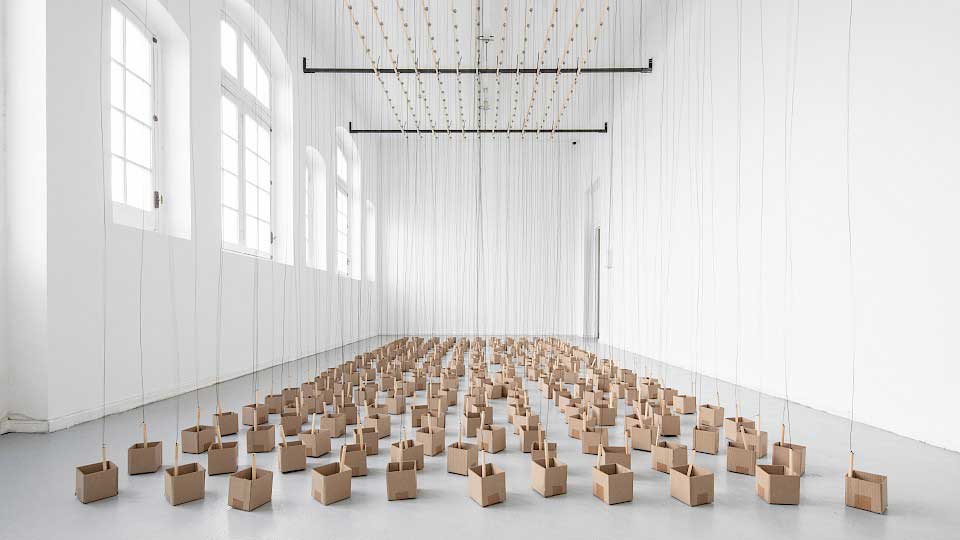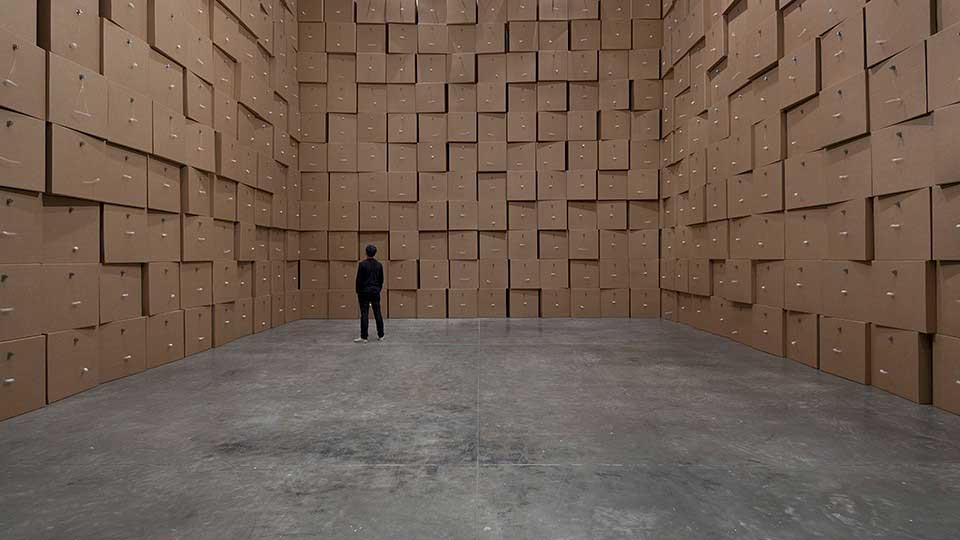Interview by Silvia Iacovcich

We adore chaos because we love to produce order, said Escher; Zimoun’s large-scale installations seem to thrive on this principle. The artist’s three-dimensional sound sculptures are obsessively arranged into a minimalistic structure: conceived as a symmetrical aggregation of industrial materials frantically moving around and possessing the space; they generate a sound made of infinite variables that are perceived as one.
Each kinetic experience follows a specific repetitive pattern, with an array of identical objects partly joined to a motorised system activated by the composer. When switched on, the DC motors power a synchronised, multi-channelled sound system, along with magnetic and uncontrollable movements from the triggered components. Outlying a ‘methodical anarchy’ that self-regulates into a ‘disorganised order’ – and vice versa – it’s the audience’s task to establish the linkage between the sonic and visual elements of each experience.
The composer employs modern, machine-made objects, those we don’t classify into the realm of beauty. For the past 15 years, Zimoun has been working with recycled materials, following a minimal waste policy: carboards, DC motors, cables, welding wires, wooden spars and ventilators have been manipulated, modified and re-adjusted into new installations. The immersive apparatus of sounds and images reproduces accidental reverberations that blend with our memory of nature and its music, feeling lively and primitive.
In his past installations, we heard the trickling of the rain coming out of plastic bags; a bonfire crackling – but it was wooden discs instead; the cracking of leaves when raindrops fall – and again, it was only cardboard boxes and wooden sticks. The process is always mechanical and organic at the same time, stimulating an essential and profound chemistry between sonic and visual elements, and the digital/physical space they inhabit.
The artist’s most recent multi-sensory project – as for all of his works – names itself upon its constituents. Following the listing of the material used for the installation, ‘1944 prepared dc motors, MDF panels 72 x 72 cm, metal discs 0 8cm, 2020’ is a dance simultaneously generated by 1944 metal discs interacting with the same number of hand-placed small motors.
The ASMR sounds are generated through the friction of the discs with their base: the result is a sensorial experience where sonic and visual patterns merge into a symphonic and hypnotic peace, through being in constant, irregular change. The project, produced in collaboration with Tetro, was commissioned by Swiss watch brand Jaeger Le-Coultre: starting from Chengdu, China, it will be presented in various cities for a global journey that will end in April 2022.
Zimoun’s sensory installations invite the audience to analyse the dispute between opposites, the authenticity that comes out from it, and the perception the viewer and listener can achieve through the kinetic experience and the sharpening of his senses. Healing, performing, exploring or merely existing – his compositions are a microcosm of the world and its metamorphosis, a dynamic system in which the whole is greater than the assembled parts.

As a self-taught artist, how did you realise you were interested in sensory experiences, what was the process towards discovering your style and who inspired you the most?
Almost everything seems to be inspiring in one way or another, somehow. Nature, architecture and space, materials, society, science, philosophies, engineering, technology, behaviours, systems and organisms, mind, consciousness, perception, and psychoactivity. It’s almost an endless list of things I like to observe and study. In the end, it is the world around inside and around us and related questions.
I am always fascinated by any kind of experts who are obsessed with what they do. It inspires me to be in exchange with such people. For a while, I was regularly in touch with Danielle Mersch, a scientist who was working at the Ants Laboratory at the University of Lausanne at that time. She specialised in the research of the social behaviour of ants. She showed me the ants lab and all the research they are doing and its current state, passed me recent papers and demonstrated how they work and the methods and technologies they use. It was fascinating and inspiring on various levels.
Since my teenage age, I also feel a strong connection to all kinds of Minimalism. In music, arts, architecture, in construction, in living. The artist I was studying the most during this time was John Cage. I was not mainly fascinated by the works he created, but by his personality, his understanding of all kinds of noises and silence in a musical context, as well by his thinking about sound, society, the world and universe, and all the methods and principles he developed to create his works.
Just before I started to work with mechanical systems in my early twenties, I was experimenting with multi-channel sound systems and did compositions for speakers spread in the space. At the time, I was working with pre-recorded sounds of physical materials, such as sounds of paper.
Driven by a minimalist approach and thinking, I started to wonder how I could get the work even more direct and create sounds in real-time on-site in the most immediate way, as opposed to recording the first and playing them later over speakers after some digital or analog processes. At that moment in time, the experimentation with mechanical systems began, and the visual intentions merged together with sound and space into the installation work I am currently doing.
How do you define being a composer, and what is the role of chance and ‘primitive complexity’ in your work?
I am intrigued by systems and methods which are as simple as possible in form and function but which develop and unfold a complexity in their behaviour. Sometimes I call this combination of primitive complexity.
In my installations, what you hear is what you see. It is not a combination of visual and acoustic elements, as both are having the same source; both are one thing. Therefore for me, the sound isn’t more important than the visual aspects, nor the other way around. I’m interested in sound as an architectural element to create and explore space, but also in sound, which somehow inhabits a room and interacts with it. I work with three-dimensional sound structures, with spatial and atmospheric experiences and the exploration of sound, material and space. And perception.
What is the process behind the creation of your installations? How do you work around the material selection and the connection between sound and visual to make it three-dimensional?
On the one hand, the choice of materials relates to a general interest in simplicity. I’m interested in simple, raw, unspectacular, and pure materials. I even call them honest materials. These are often everyday or industrial materials which are not designed to look nice. But I think they are often more beautiful than material created specifically to look nice. On the other hand, my choice of materials strongly relates to the dynamics and behaviour of the materials and their resonance properties. The choices are based on visual, haptic, functional and auditive criteria.
I often work with a large number of the same mechanical systems or elements. Here the repetition and multiplication interest me from different points of view: on the one hand, I’m looking for individual dynamics growing out of the systems. In that sense, each multiplied module is often behaving in its way and has many elements based on the same materials and systems next to each other, showing all these individual behaviours and differences. It allows us to study them.
On the other hand, multiplication interests me concerning the three-dimensionality of the work. If many mechanical systems generating sounds are spread all over the space, this creates a three-dimensional space of sound. In that sense, a sound structure can get very complex, even if it’s based on many straightforward and sometimes even primitive little mechanical systems or elements.
Your work spans from visual uncontrolled accidental compositions to musical compositions for sound recordings and performances that are laboriously constructed in the studio. What is the connection between the two worlds – if there is any?
The vital interest behind it is the same. Investigations of space, spatial influences, explorable atmospheres and microstructures. Enterable and observable spaces and fields and their states of presence. In purely acoustic works, the sound production is not directly understandable to the eye and, in this sense, is more abstract.
However, I see both dealing with quite a number of the same themes and for me, it feels more like looking at the same sculpture from different perspectives, using different lighting or with the use of a magnifying glass.
Your work underlines a series of tensions similar to those found within the artificial and the organic; what is your relationship with technology and nature?
Nature and technology are both fascinating and raise many questions. I am interested in the simultaneity of such opposites as simplicity and complexity, artificial systems that develop an apparent vitality and feel organic, or order and chaos, mass and individuality. Such opposites also contribute in a certain sense to the creation of mental spaces. Explorable spaces.
When experiencing your work, one is forced to enter a focussed contemplative state, sharpening the listening – it feels to me like a healing process. Is it intentional?
I keep my works significantly reduced and raw. That way, they function more like code-behind things rather than just creating one connection to one thing. In this way, the works can ideally activate the visitors somehow and allow us to make our connections, associations and discoveries on different individual levels. I hope they might open fields of potential for observing and will enable us to reflect and wonder, to think and question our surroundings and ourselves.
I create those works based on many different interests coming together, and I see them in many different ways and layers myself. Subjectivity is the base of how we see, understand and don’t understand the world. In that sense, while exploring the works, the viewer starts to play an essential and creative part as well.
What is the chief enemy of creativity?
Inactivity.
You couldn’t live without…
Astonishment.






